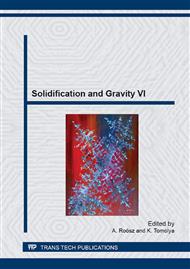[1]
H. Fredriksson, J. Stjerndahl, J. Tinoco, On the solidification of nodular cast iron and its relation to the expansion and contraction, Mat. Sci. and Eng. A. 413-414 (2005) 363-372.
DOI: 10.1016/j.msea.2005.09.028
Google Scholar
[2]
A. Burbelko, E. Fraś, D. Gurgul, W. Kapturkiewicz, J. Sikora, Simulation of the ductile iron solidification using a cellular automaton, Key Eng. Mat. 457 (2011) 330-336.
DOI: 10.4028/www.scientific.net/kem.457.330
Google Scholar
[3]
G Nandori, Relation between the volume change during the solidification of lamellar and ductile cast iron and the crystallization sequence, Mat. Sci. Forum. 215-216 (1996), 399-407.
DOI: 10.4028/www.scientific.net/msf.215-216.399
Google Scholar
[4]
Z. Gedeonova et al., Displacement of the Surface Mould and Metal during the Solidification of Nodular Graphite Iron Casting, Mat. Sci. Forum. 215-216 (1996) 391-398.
DOI: 10.4028/www.scientific.net/msf.215-216.391
Google Scholar
[5]
I. Ohnaka, A. Sato, A. Sugiyama, F. Kinoshita, Mechanism and estimation of porosity defects in ductile cast iron, Int. J. of Cast Met. Res. Vol. 21, no 1-4, 2008, pp.11-16.
DOI: 10.1179/136404608x361585
Google Scholar
[6]
The Sorelmetal Book of Ductile Iron. Rio Tinto Iron & Titanium, (2004).
Google Scholar
[7]
A.R. Umantsev, V.V. Vinogradov, V.T. Borisov, Mathematical modeling of the dendrite growth during the solidification from undercooled melt, Kristallografia. 30 (1985) 455-460.
Google Scholar
[8]
M. Rappaz, Ch.A. Gandin, Probabilistic Modelling of Microstructure Formation in Solidification Processes, Acta Met. et Materialia. 41 (1993) 345-360.
DOI: 10.1016/0956-7151(93)90065-z
Google Scholar
[9]
S. Pan, M. Zhu, A three-dimensional sharp interface model for the quantitative simulation of solutal dendritic growth, Acta Materialia. 58 (2010) 340-352.
DOI: 10.1016/j.actamat.2009.09.012
Google Scholar
[10]
G. Guillemot, Ch.A. Gandin, M. Bellet, Interaction between single grain solidification and macrosegregation: Application of a cellular automaton-finite element model, J. of Cryst. Growth. 303 (2007) 58-68.
DOI: 10.1016/j.jcrysgro.2006.12.076
Google Scholar
[11]
L. Beltran-Sanchez, D.M. Stefanescu, A quantitative dendrite growth model and analysis of stability concepts, Metall. Mat. Trans. A. 35 (2004) 2471-2485.
DOI: 10.1007/s11661-006-0227-3
Google Scholar
[12]
V. Pavlyk, U. Dilthey, Simulation of weld solidification microstructure and its coupling to the macroscopic heat and fluid flow modelling, Model. Simul. Mat. Sci. Eng. 12 (2004) 33-45.
DOI: 10.1088/0965-0393/12/1/s03
Google Scholar
[13]
M.F. Zhu, C.P. Hong, A three dimensional modified cellular automaton model for the prediction of solidification microstructures, ISIJ Int. 42 (2002) 520-526.
DOI: 10.2355/isijinternational.42.520
Google Scholar
[14]
D.S. Svyetlichnyy, Reorganization of cellular space during the modeling of the microstructure evolution by frontal cellular automata, Comput. Mater. Sci. 60 (2012), 153-162.
DOI: 10.1016/j.commatsci.2012.03.029
Google Scholar
[15]
A.A. Burbelko, E. Fraś, W. Kapturkiewicz, D. Gurgul, Modelling of dendritic growth during unidirectional solidification by the method of cellular automata, Mat. Sci. Forum. 649 (2010) 217222.
DOI: 10.4028/www.scientific.net/msf.649.217
Google Scholar
[16]
D.J. Jarvis, S.G.R. Brown, J.A. Spittle, Modelling of non-equilibrium solidification in ternary alloys: comparison of 1D, 2D, and 3D cellular automaton-finite difference simulations, Mat. Sci. Techn. 16 (2000) 1420-1424.
DOI: 10.1179/026708300101507389
Google Scholar
[17]
A.A. Burbelko, E. Fraś, W. Kapturkiewicz, E. Olejnik, Nonequilibrium kinetics of phase boundary movement in cellular automaton modelling, Mat. Sci. Forum. 508 (2006) 405-410.
DOI: 10.4028/www.scientific.net/msf.508.405
Google Scholar
[18]
M. Zhu, S. Pan, D. Sun, H. Zhao, Numerical Simulation of Microstructure Evolution During Alloy Solidification by Using Cellular Automaton Method, ISIJ International. 50 (2010) 1851-1858.
DOI: 10.2355/isijinternational.50.1851
Google Scholar
[19]
H.L. Zhao, M.F. Zhu, D.M. Stefanescu, Modeling of the divorced eutectic solidification of spheroidal graphite cast iron, Key Eng. Mat. 457 (2011) 324-329.
DOI: 10.4028/www.scientific.net/kem.457.324
Google Scholar
[20]
W. Kapturkiewicz, A.A. Burbelko, E. Fraś, M. Górny, D. Gurgul, Computer modelling of ductile iron solidification using FDM and CA methods, J. Achiev. Mat. Manuf. Eng. 43 (2010) 310323.
DOI: 10.4028/www.scientific.net/kem.457.330
Google Scholar
[21]
A.A. Burbelko, D. Gurgul, W. Kapturkiewicz, M. Górny, Cellular automaton modelling of ductile iron microstructure in the thin wall casting, Mat. Sci. Eng. 33 (2012) 012083. 1-9.
DOI: 10.1088/1757-899x/33/1/012083
Google Scholar
[22]
D. Gurgul, A.A. Burbelko, E. Fraś, E. Guzik, Multiphysics and multiscale modelling of ductile cast iron solidification, Arch. Foundry Eng. 10 (2010) 35-40.
Google Scholar
[23]
D. Gurgul, A. Burbelko, Simulation of Austenite and Graphite Growth in Ductile Iron by means of Cellular Automata, Arch. Met. Mater. 55 (2010) 53-60.
Google Scholar
[24]
J. Hoyt and M. Asta, Atomistic computation of liquid diffusivity, solid-liquid interfacial free energy, and kinetic coefficient in Au and Ag, Phys. Rev. B. 65 (2002) 214106. 1-11.
DOI: 10.1103/physrevb.65.214106
Google Scholar
[25]
A. Burbelko, Modeling of solidification process by cellular automata method, UWND AGH, Krakow, 2004 (in Polish).
Google Scholar
[26]
H.L. Lukas, S.G. Fries, B. Sundman, Computational Thermodynamics: The Calphad Method, University Press, Cambridge, (2007).
DOI: 10.1017/cbo9780511804137
Google Scholar
[27]
A.A. Burbelko, D. Gurgul, M. Królikowski, M. Wróbel, Cellular automaton modeling of ductile iron density changes at the solidification time. Submitted to Arch. Foundry Eng., (2013).
DOI: 10.2478/afe-2013-0074
Google Scholar


